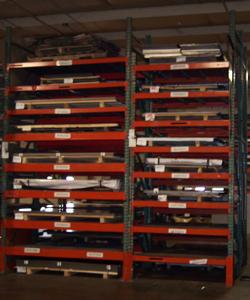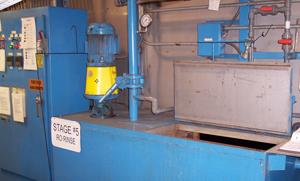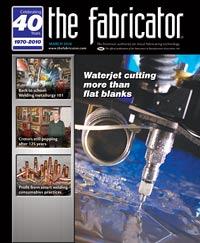Editor-in-Chief
- FMA
- The Fabricator
- FABTECH
- Canadian Metalworking
Categories
- Additive Manufacturing
- Aluminum Welding
- Arc Welding
- Assembly and Joining
- Automation and Robotics
- Bending and Forming
- Consumables
- Cutting and Weld Prep
- Electric Vehicles
- En Español
- Finishing
- Hydroforming
- Laser Cutting
- Laser Welding
- Machining
- Manufacturing Software
- Materials Handling
- Metals/Materials
- Oxyfuel Cutting
- Plasma Cutting
- Power Tools
- Punching and Other Holemaking
- Roll Forming
- Safety
- Sawing
- Shearing
- Shop Management
- Testing and Measuring
- Tube and Pipe Fabrication
- Tube and Pipe Production
- Waterjet Cutting
Industry Directory
Webcasts
Podcasts
FAB 40
Advertise
Subscribe
Account Login
Search
Green efforts save greenbacks
DeWys Manufacturing finds out that green manufacturing isn't a waste
- By Dan Davis
- April 30, 2010
- Article
- Shop Management

Figure 1: DeWys Manufacturing management determined that it could reduce the variety of material sheet sizes it bought, which will translate into tighter nests and less material waste. The newfound raw material storage space then can be turned into manufacturing space.
When you are president of a company, you might observe things that others don’t even notice. That just comes with the territory when you are dealing regularly with profit and loss statements.
Jon DeWys, president of DeWys Manufacturing, a Grand Rapids, Mich.-based precision fabricator, noticed that a disposal truck was showing up at the company frequently to haul away wastewater.
“It seemed like the truck was here every three weeks,” DeWys said.
The company wasn’t hooked up to a city sewer system, so any waste generated by the company, more specifically by its five-stage pretreatment system for its powder coating line, fed right into its own septic tank. That tank needed to be cleaned out quite frequently, and each service call added to cleanup costs. Most of the employees saw a simple waste hauler; DeWys saw a money pit.
Not so coincidentally, the company had just undergone a rigorous environmental audit in 2008 and earned recognition by the Green Suppliers Network as a company that had streamlined product practices and used materials more efficiently, not heaping needless waste into the environment. Wastewater was one of the first areas the DeWys Manufacturing team targeted and studied.
Two years later, that waste hauler doesn’t haul away as much wastewater. Through increased employee vigilance and better monitoring of equipment, the company has cut its annual water usage by 58 percent when comparing 2009 with 2007. Those numbers are normalized to sales, so the huge improvement is real, not just a result of the slowdown in business that everyone had to live through in 2009.
That was the first of several lessons that DeWys learned about being “lean and clean,” as William Stough, CEO of Sustainable Research Group, described this approach to green manufacturing. Like lean, the lessons keep coming because this brand of environmentally responsible manufacturing is also about continuous improvement.
Getting the Green Light
Stough’s firm assisted DeWys Manufacturing with its first audit in 2008 and its most recent one in 2010. Stough said it shouldn’t come as a surprise that the principles associated with the Green Suppliers Network are similar to those of lean manufacturing. That’s the way the founders of the program intended it.
The network is a joint effort of the U.S. Environmental Protection Agency (EPA) and the U.S. Department of Commerce’s National Institute of Standards and Technology (NIST) and its affiliate, the Manufacturing Extension Partnership (MEP). In Stough’s cut-and-dried explanation of the history of the Green Suppliers Network: EPA saw MEP’s success in championing lean manufacturing practices and thought that teaming up with NIST could spread the word about the savings that can be achieved with literally eliminating waste. The initial pilot began in February 2001 with General Motors and its Saturn division and eventually rolled out to other industry segments in December 2003.
Steelcase, the office furniture company with headquarters in Grand Rapids, Mich., soon encouraged its own supply chain to become part of the Green Suppliers Network, and that helped pull DeWys Manufacturing into the mix. A one-time $7,500 grant from Steelcase and the DOC helped DeWys Manufacturing offset a majority of the initial costs of conducting an audit and enacting subsequent changes.

Figure 2: Instead of dumping and refilling all five tanks of the pretreatment system for DeWys Manufacturing's powder coating system with fresh water, the manufacturing team now fills the first tank with fresh water and backflows the rest of the tanks, dumping the dirtiest water and using fresh water to top off the other tanks if necessary.
Stough said that when approaching companies about the efforts of the Green Suppliers Network, he always tries to speak in terms that manufacturing management understands: dollars.
“When we identify a green opportunity, we put a dollar [amount] on it, so you can compare apples to apples,” he said.
To illustrate his approach, Stough pointed to a typical manufacturer’s recycling program. The manufacturer knows exactly how many pennies per pound it gets for selling metal scrap, and honestly, most are pretty happy with that figure. However, that same manufacturer really hasn’t considered how many dollars the company could save by eliminating unnecessary metal purchases.
That type of proposition is an easy sell to manufacturers that live by lean manufacturing practices. DeWys Manufacturing is one such company, boasting four lean-certified trainers, regularly tackling new projects to root out waste, and keeping the company’s 120 employees notified about lean plans and performance outcomes.
“You can throw money at green [initiatives], but that doesn’t mean that those efforts will last,” DeWys said.
The First Step
DeWys joked that the 65,000-square-foot shop floor is always in a state of movement. The company is keenly aware that whatever space can be reclaimed from manufacturing eventually can be used to accommodate new production efforts.
When a visitor walks onto the shop floor, he or she walks into the midst of several “value streams”. Nine of these value streams stretch from material storage on one side of the building through fabrication areas, to welding or finishing, and finally to shipping.
The family of parts that belong to these value streams all have similar specs. For instance, laser-cut parts that require only a few bends on press brakes before heading on material carts to be welded might be a part of one value stream. Another value stream might call for laser-cut parts to be formed on the company’s new Salvagnini automated bending cell and then moved to a hardware insertion machine before moving along to powder coating.
This type of production flow was perfect for establishing more environmentally friendly manufacturing practices because the management team could target one strategic area of the business, not simply launch numerous efforts that would have been ignored easily during the trying months of 2009.
“We try to do these types of programs in this manner and keep it very practical,” Stough said.
In targeting a product family that may be found in one of these value streams, Stough said the team should take a look at material efficiency, energy intensity used during the manufacturing process, and the use of toxic and hazardous materials. Once data has been collected, the team can decide what objectives are to be met and establish metrics to achieve the agreed-upon goals.
One of the first areas to grab the attention of manufacturing was raw material usage. Chris Hawkins, the company’s manufacturing manager, said the company was ordering all sorts of sheet sizes for its fabrication needs.
“Instead of having all of the sizes and opportunities for waste, we looked at how we could optimize,” he said.
As an example, Hawkins said the company was ordering five different sizes of 18-gauge steel. In 2009 they settled on two sizes.
The benefits are easy to see, according to Hawkins. DeWys Manufacturing doesn’t have to accommodate as many different sizes of sheet metal, so it can live with fewer raw material shelves (see Figure 1). Setup times for laser cutting jobs are reduced because operators aren’t changing out sheet sizes as often in the midst of a shift’s production run. The purchasing department is getting a break from material suppliers because they are making larger and less varied orders.
Nothing good comes without a little bit of pain, however. DeWys Manufacturing is in the process of migrating 6,000 part numbers over to new dynamic nesting programs that accommodate the new sheet sizes. It hasn’t been an overnight transition, but Hawkins said the transition should be finished in the coming months.
DeWys Manufacturing has reduced its water usage dramatically through better management of its five-stage pretreatment process (see Figure 2), but that’s not where the savings end. If the pretreatment line is reusing water, it also is reusing some of the pretreatment chemicals. As a result, the company doesn’t have to buy as many chemicals, and the environment benefits because fewer chemical compounds are fed into the waste stream.
“It’s always a good practice to do this because you can see all the dominoes begin to fall,” said Hawkins, as he described how one green improvement affects other areas of the business.
Not all improvements are huge, but they do make a difference. For example, electricity usage has dropped only 14 percent during the time between the two environmental audits, but that success occurred without a major push.
DeWys is excited about the potential impact that these green projects will have on the company. So much of last year was about “surviving,” he said, that only in the past six months has DeWys Manufacturing really hit its stride in tackling these projects.
In 2010 the fabricator will take a look at its natural gas consumption. Running a pretreatment line, which requires natural gas for heating the spraying systems and the dry-off oven, and a curing oven for the newly powder-coated (see Figure 4) parts requires a lot of energy, and small changes in operating procedures hold the potential for large savings.
Of course, the company will continue to look at eliminating more waste as it relates to electricity, material, and water usage. After all, it is about continual improvement—and not just for DeWys Manufacturing, but all of manufacturing.
“Manufacturers have to be good stewards of the world,” said C.T. Martin, the company’s vice president. “Manufacturing has had the reputation of making a profit at the expense of the environment. We’ve got to turn that around.”
About the Author

Dan Davis
2135 Point Blvd.
Elgin, IL 60123
815-227-8281
Dan Davis is editor-in-chief of The Fabricator, the industry's most widely circulated metal fabricating magazine, and its sister publications, The Tube & Pipe Journal and The Welder. He has been with the publications since April 2002.
subscribe now

The Fabricator is North America's leading magazine for the metal forming and fabricating industry. The magazine delivers the news, technical articles, and case histories that enable fabricators to do their jobs more efficiently. The Fabricator has served the industry since 1970.
start your free subscription- Stay connected from anywhere

Easily access valuable industry resources now with full access to the digital edition of The Fabricator.

Easily access valuable industry resources now with full access to the digital edition of The Welder.

Easily access valuable industry resources now with full access to the digital edition of The Tube and Pipe Journal.
- Podcasting
- Podcast:
- The Fabricator Podcast
- Published:
- 05/07/2024
- Running Time:
- 67:38
Patrick Brunken, VP of Addison Machine Engineering, joins The Fabricator Podcast to talk about the tube and pipe...
- Trending Articles
How laser and TIG welding coexist in the modern job shop

Young fabricators ready to step forward at family shop

Material handling automation moves forward at MODEX

A deep dive into a bleeding-edge automation strategy in metal fabrication

BZI opens Iron Depot store in Utah

- Industry Events
Laser Welding Certificate Course
- May 7 - August 6, 2024
- Farmington Hills, IL
World-Class Roll Forming Workshop
- June 5 - 6, 2024
- Louisville, KY
Advanced Laser Application Workshop
- June 25 - 27, 2024
- Novi, MI
Precision Press Brake Certificate Course
- July 31 - August 1, 2024
- Elgin,


























